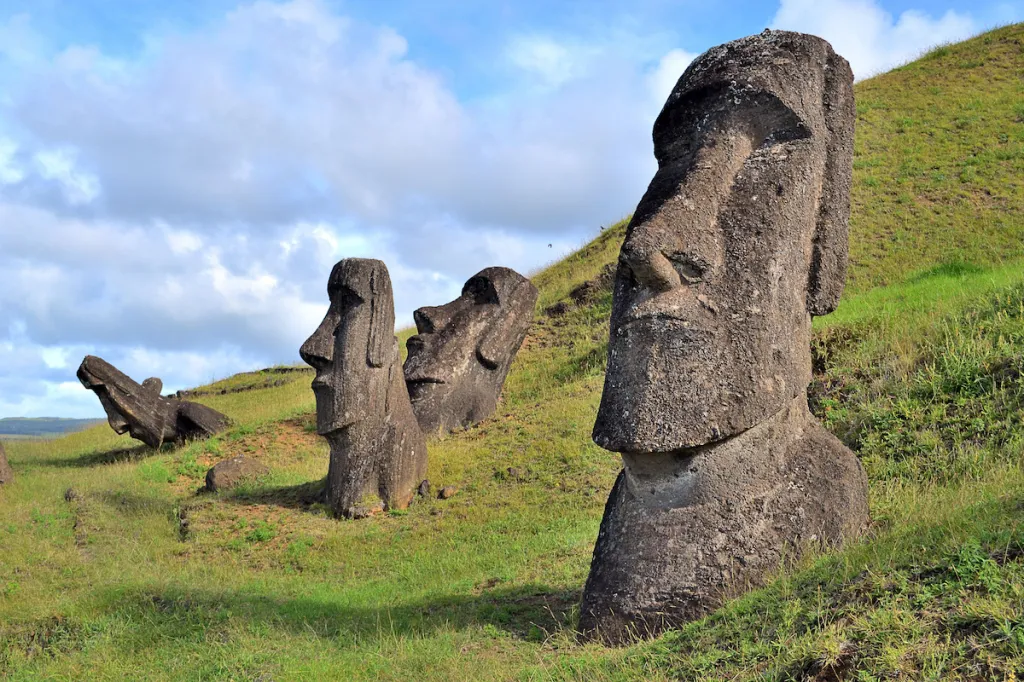Many questions about the famous moai statues on Easter Island, Chile, have long eluded scholars—from their cultural significance to how they were made and transported.
A recent study in the Journal of Archaeological Science by archaeologists Carl Lipo of Binghamton University and Terry Hunt of the University of Arizona poses the theory that the 92-ton statues were transported in a vertical position, with movers using ropes to “walk” the moai across the island and onto their ahu, or platforms.
This theory is supported by the oral traditions of the island’s Indigenous Rapa Nui people, which reference the moai “walking” from the quarry where the statues were carved to their platforms.
While Lipo had previously conducted rudimentary field tests suggesting the technique was possible, his hypothesis also drew criticism. His new paper addresses that with fresh experimental evidence using three-dimensional modeling of the statues’ physics, along with new field tests that recreate the “walking” motion.
Out of a database of 962 moai identified on the island through field surveys and photogrammetric documentation, Lipo and Hunt focused on 62 statues situated along ancient transport roads that appear to have been abandoned mid-“walk.”
They found that, compared to moai successfully mounted on ahu, these statues had much wider bases relative to shoulder width. The wider base creates a more stable foundation that lowers the center of mass, making the statue more conducive to the side-to-side “walking” motion without falling over during transport.
The moai also feature a forward lean between six and 15 degrees from the vertical position that moves the center of mass close to or slightly beyond the base’s front edge. When laterally tilted, this engineering would cause the statue to fall forward, with the rounded front base edge acting as a crucial pivot point. The rocking motion caused by people pulling a few strong and well-positioned ropes would result in a forward “step” for the statue.
The researchers believe that carvers then modified the statues when they arrived at their respective platforms, cutting away rock from the front of the statues to erase the lean used to move them. In so doing, they shifted the center of mass to the base area, placing the moai in a more stable, upright position.
The team used three-dimensional modeling to create a scaled replica of one such moai weighing 9,590 pounds, with the same proportions and mass distribution. They found that it would have taken 18 people—four on each lateral rope and 10 on a rear rope—to rock the statue side to side. If done correctly, it would have taken just 40 minutes to move the statue 328 feet.
It is possible, however, that these statues could have been moved by smaller groups of people over a longer period. Once the “walking” movement began, the statue became easier to move and required fewer people as it built momentum.
The use of this method by the Rapa Nui “suggests a sophisticated understanding of resonance principles,” a technique that utilizes a gradual increase in amplitude, Lipo and Hunt wrote.
The study draws on earlier work by Czech experimental archaeologist Pavel Pavel, who conducted similar experiments on Easter Island in the 1980s. He and his team were able to demonstrate a kind of “walking” motion, but Pavel used moai already mounted on ahu for his experiments and therefore did not account for the pre-cut shape that Lipo and Hunt analyzed.
The pair also examined the roads on which the statues would have been transported. They found that the concave shape of the roads would have helped limit excessive rocking movement during vertical transport. The roads have only a 2 to 3 percent slope, and for the infrequent steeper sections, field experiments indicated the incline could be managed with more controlled stepping.
As for the abandoned moai used in the study, Lipo and Hunt believe they were left due to mechanical failure during the transport process.
